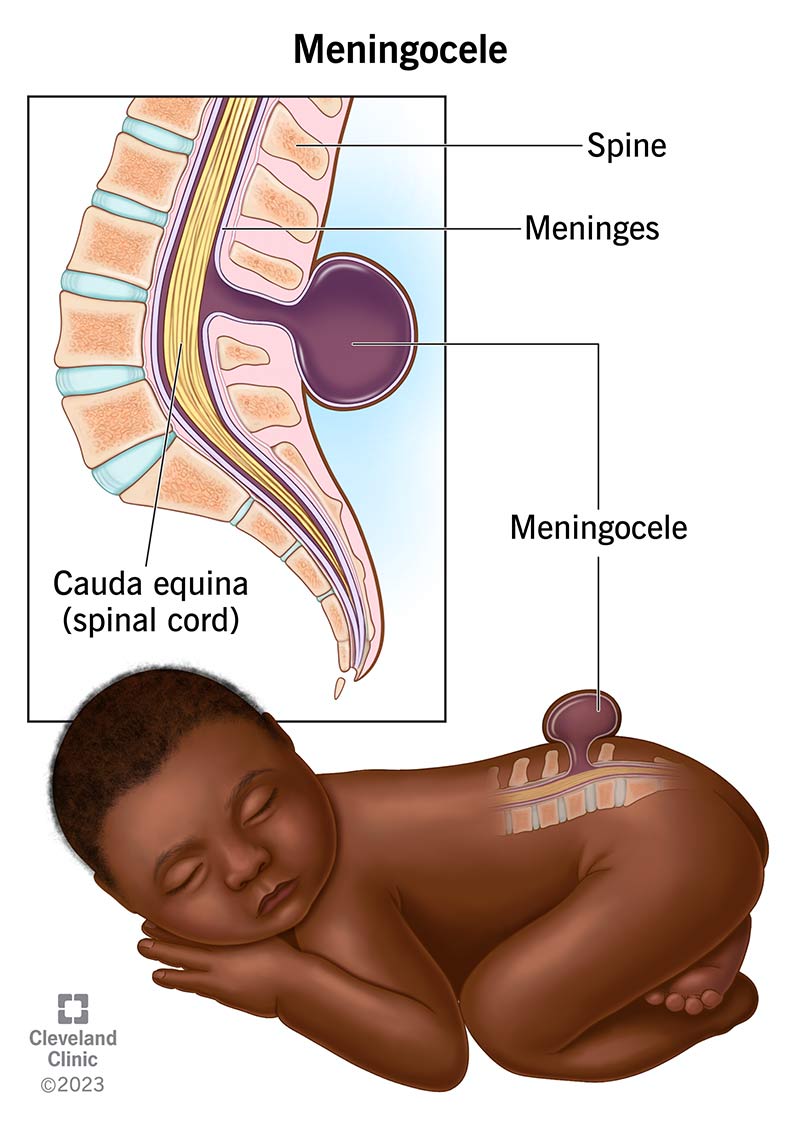Meningocele is a type of spina bifida. It causes the protective layer around your baby’s spinal cord to push through an opening in their spine. A surgeon can repair it shortly after birth. Most children recover well with few long-term issues.
Advertisement
Cleveland Clinic is a non-profit academic medical center. Advertising on our site helps support our mission. We do not endorse non-Cleveland Clinic products or services. Policy

Meningocele (pronounced “men-IN-go-seel”) is a condition where the protective layers around your baby’s spinal cord (meninges) stick out through a gap in their spine. It forms a bulge or a sac on their back. This occurs if the lower end of the neural tube doesn’t develop as expected during fetal development.
Advertisement
Cleveland Clinic is a non-profit academic medical center. Advertising on our site helps support our mission. We do not endorse non-Cleveland Clinic products or services. Policy
The lower spine is the most common spot for a bulge or sac to form. The sac is filled with fluid called cerebrospinal fluid (CSF). CSF normally cushions and protects your child’s brain and spinal cord.
Healthcare providers treat it with surgery within days after your baby is born. It rarely causes long-term or serious medical issues.
This condition is the least common type of spina bifida.
There are two types:
The most noticeable sign is a fluid-filled lump (sac) on your baby’s back.
Symptoms aren’t common with this condition, but they may include:
Like other types of spina bifida, this condition is a neural tube defect. The neural tube is an embryonic structure that develops into the brain and spinal cord. In meningocele, the spinal cord itself develops as expected. But the bones of the spine (vertebrae) don’t close completely. This leaves a gap in the spinal column.
The meninges (the protective membranes covering the spinal cord) push out through this gap, forming a fluid-filled sac. This sac contains the cerebrospinal fluid. As a result, the sac sticks out from your child’s back.
Advertisement
Research suggests that women with certain chronic conditions, like diabetes, or who take certain antiseizure medications, may have an increased risk of having a fetus with meningocele if they’re pregnant.
If you plan on expanding your family, talk to your providers to learn more about these risk factors and ways to have a healthy pregnancy.
Complications may include:
Healthcare providers may see signs of this condition while doing routine prenatal blood and urine tests. But usually, they’ll diagnose it after your baby is born. Providers typically take imaging tests to confirm a diagnosis. These noninvasive tests may include:
If providers detect this condition in the fetus, they may recommend a C-section (cesarean birth). This prevents damage to the sac around the spinal cord during delivery.
Surgery to remove the fluid-filled sac often cures the condition. In meningocele repair, your child’s surgical team will:
If your child has an open type without skin around the sac, surgery may happen within 24 to 48 hours after birth. For the closed type, surgery may happen within 72 hours.
After the procedure, your newborn may need to spend up to two weeks in the hospital.
While this procedure is generally safe, it does come with some risks. These may include:
Your child’s surgical team will take extra precautions to prevent complications and make sure your child is safe.
After surgery, your child’s surgeon will schedule regular visits to make sure they’re healing as expected. These visits will be in addition to seeing their pediatrician for regular check-ups to monitor their wellness and growth. If you have any questions about your child’s healing or development, reach out to their care team.
Your newborn’s healthcare providers will treat this condition quickly to prevent complications. Repairs usually have a successful outcome. You can expect to bring your child home from the hospital within a couple of weeks after they’ve healed from surgery. Stay up to date on their check-ups as they grow to make sure they don’t have any lingering issues (these are rare).
When you hear “spina bifida,” you might think of the most common and most serious type. While meningocele is a form of spina bifida, its symptoms are usually less severe. In many cases, surgery shortly after birth resolves the issue, and long-term complications are rare.
Advertisement
Knowing this may ease some of your worries. If your baby is born with this condition, don’t hesitate to ask questions and share your concerns with their healthcare team.
Advertisement
Learning your child needs brain surgery can turn your life upside down. Cleveland Clinic Children’s neurosurgery experts are here to help make things right.

Last reviewed on 10/08/2025.
Learn more about the Health Library and our editorial process.